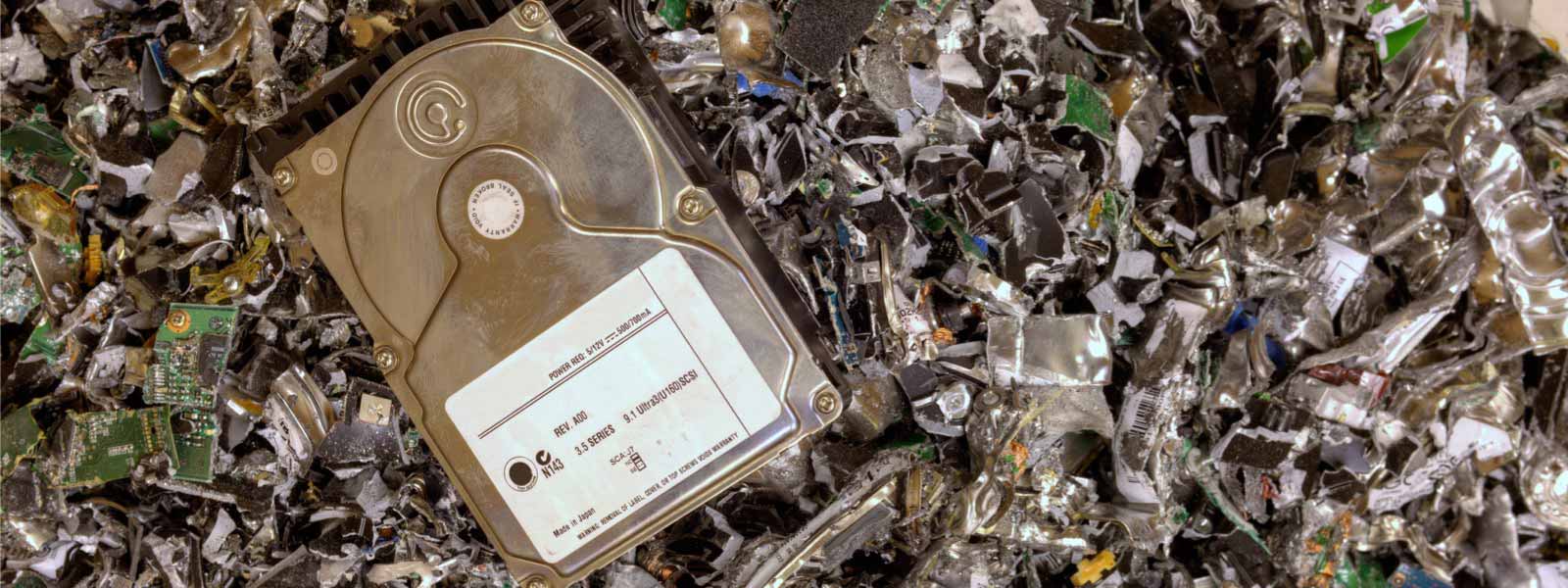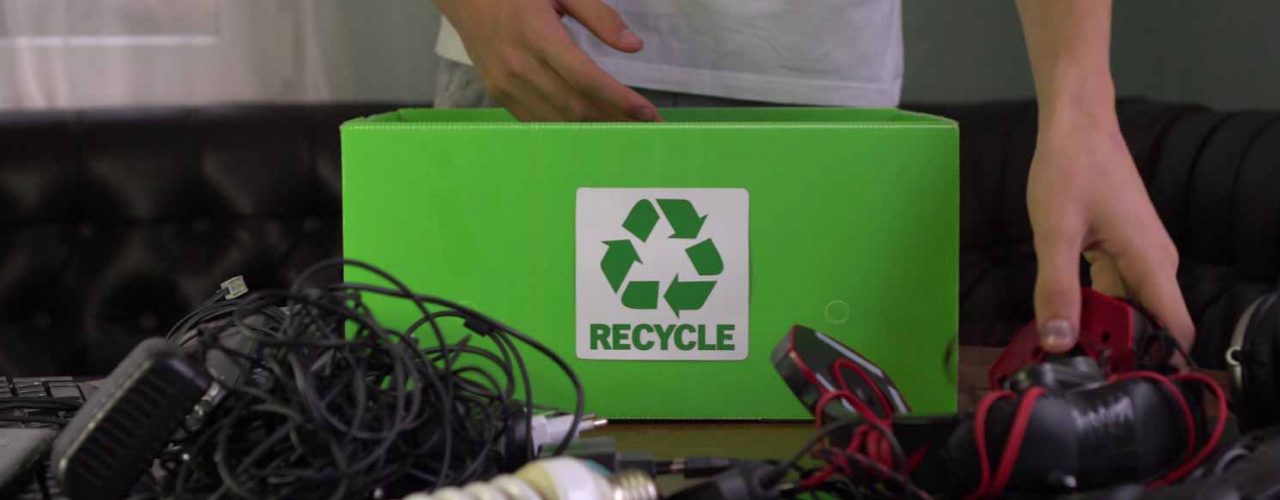What is Hard Drive Disposal?
Securely Dispose of Hard Drives and SSDs
In a world that’s incredibly dependent on electronic equipment and Information Technology, individuals and organizations must routinely grapple with issues concerning how to destroy data on a hard drive and secure hard drive disposal.
In this article, we’ll be exploring some of these issues, including ways to destroy the hard drive before disposal and methods for disposing of hard drives safely.
Information is the lifeblood of commerce and industry in today’s economy. From paper documents to DVDs, mobile phones, and computer hard drives, the data resident on these storage media fuels business decision making, facilitates transactions and provides individuals and organizations with essential archives.
Over time, these data storage repositories may fill up to the point where they have to be replaced. In addition, most digital and electronic storage and information processing equipment on the market are designed with limited service life, giving manufacturers the chance to introduce new and improved models and buyers the opportunity to upgrade their systems.
When this happens, device owners are faced with the dilemma of what to do with their old hardware and storage media. They might, for example, donate old but still usable equipment to charities or schools or sell it to a third party. Recycling is another option. So too, is simply throwing the unwanted equipment away.
What Is a Hard Drive Disposal?
Many people assume that simply deleting all the information on a hard drive or reformatting the disk is enough. It isn’t, as either of these mechanisms may leave traces of information on the hard drive, making it possible to retrieve all the data either in its original form or in a format that can be used to restore the original.
If a serviceable hard drive with traces of information intact falls into the hands of a cybercriminal, you could effectively be handing them the keys to your personal or corporate cache of secrets — simply by not having disposed of the hard drive properly. This is why the imperative to “erase a hard drive before disposal” is critical to data security.
Once cleansed or sanitized of all the data it contains, hard drive disposal must then be undertaken in a manner that similarly takes your information security into account.
The best way to do this is to destroy the hard drive before disposal and to effect that disposal in such a manner that the physical remnants leave no traces of recoverable information intact.

Most laypeople don’t possess the equipment or expertise to achieve this on their own. For this reason, it’s advisable to seek the assistance of a hard drive disposal service — a professional organization that’s dedicated to the sanitization, destruction, and disposition of hard drives and other IT or electronic equipment on a contract basis.
Such an organization will be best able to advise you on the hard drive disposal procedure most appropriate for your hardware and will provide the resources required to implement these techniques.
Your data security stance also depends on your regulatory compliance status and position within your own organization’s internal data privacy and cyber security policies. To this end, each drive processed by the service should be accompanied by a hard drive disposal certificate, confirming the hardware’s identity and what was done to it.
How to Dispose of Hard Drives
To protect yourself against the dangers that arise when sensitive information falls into the wrong hands, the best way to dispose of computer hard drive and electronic media is to make sure that all data resident on hard drives and other storage devices is obliterated, to the point where it can’t be reconstructed and reused.
The recoverability of the data on a storage device and the physical viability of the device itself are the two main considerations governing how to properly dispose of a hard drive.
Physically breaking up a hard drive can do extensive damage to the data that’s stored on it, but may not in itself be the most secure method for disposing of hard drives safely. Physical destruction simply makes the data unusable but doesn’t remove it completely from the body of the drive.
The best way to dispose of hard drives is to render the data on them completely unrecoverable, and to make it physically impossible to reconstitute any of this information from the physical residue of the disposal process.
To securely dispose of old hard drives then, it may be necessary to employ a combination of two or more techniques.
In this regard, your hard drive disposal service will be able to assist and advise on how to dispose of hard drives in the most appropriate manner.

Make an Informed Decision
Physically Destroying Your Hard Drive
The injunction to destroy hard drive before disposal applies pretty much universally for individuals and organizations looking to physically dispose of their computer equipment.
But the question of how to destroy your computer hard drive throws up several options, the choice of which may depend on the nature of your hardware, the level of confidentiality of the information it contained, and other factors.
These options include:
Hard Drive Shredding
To destroy your hard drive by shredding, a special device called an hdd shredder will physically break a hard drive down into smaller parts. The shred residue largely consists of chunks of metal. For secure hard drive disposal, the shredding machine should break the storage device down into minuscule pieces, which are virtually impossible for anyone to put back together. Some hdd shredder machines will also compress the shredded material into compact forms for disposal.
Crushing of Hard Drives
In a hard drive crusher, the machinery employs a heavyweight mechanism to exert sustained pressure on the storage hardware, which ultimately breaks the magnetic platter and internal circuitry beyond repair or recovery.
Though this technique may be implemented to destroy hard drive units within an office or warehouse for on-site destruction, the techniques and machinery involved are highly specialized.
Disintegration of Hard Drives
Similar to shredding, hard drive disintegration breaks the storage device into smaller, irregularly shaped chunks of metal. However, the resulting material is much smaller in size than shred residue, making it more difficult for forensic methods to retrieve data from it and provide a higher security level. For this reason, disintegration is often the disposal method of choice for organizations looking to dispose of highly classified material.
As a hard drive destroyer, a disintegrator machine typically has a conveyor belt system and cutting knife, which slices hard drives and storage media into tiny particles that cannot be reassembled. The machines require serious ventilation and are therefore unsuitable for an office environment.
Melting of Hard Drives
If you want to destroy old hard drive equipment by melting, the process typically involves immersing the drives in a powerful acid to destroy their platters and housing. In some melting procedures, the hard drives are taken to a metal recycling center and dumped into a large vat of molten steel. More commonly, a concentrated bath of hydrochloric and nitric acids is used in a process that's highly effective for hard drive destruction, but which requires specialist techniques for implementation and disposal of the waste products.
Secure Hard Drive Disposal
At state, federal, and even international levels, there are numerous statutes and regulatory frameworks that govern safe practices for secure hard drive disposal. Some have specific applications for organizations in certain industries, while others may provide guidelines and best practices that apply more generally.
For example, the NSA Classified Material Conversion (CMC) stipulates “the disposition of classified material through the use of standard industrial conversion or approved destruction methods via numerous recycling and reclamation procedures in strict accordance with environmental, safety, and security standards.” Although the CMC service is only available to NSA/CSS elements, other Intelligence Community (IC) members, and certain US military units, the guidelines in the framework can be adopted as best practices to securely dispose of old hard drives in the civilian sector, as well.

In the healthcare sector, the Health Insurance Portability and Accountability Act (HIPAA) applies to hospitals, doctors, pharmacies, health plans, medical billing companies, and any other corporate entity involved in the healthcare industry or managing personal health information (PHI) or electronic personal health information (ePHI). This includes universities and any other institutions that store student or member health records and occasionally have a need to securely dispose hard drive and other data storing equipment.
In terms of how to securely dispose of hard drive and data storage media, HIPAA requires that electronic media containing ePHI should be rendered “unusable and/or inaccessible.” One method stipulated in the framework is to “physically damage it [the hard drive] beyond repair, making the data inaccessible.” All digital media coming into or leaving the custody of a covered entity should be properly inventoried and reported.

See how much your IT equipment is worth
Hard Drive Disposal Methods
As we have noted, among the physically destructive hard drive disposal methods are shredding, crushing, disintegration, and melting. However, there are also non-destructive techniques that may, for example, be employed in the disposition of IT assets for reuse or onward sale.
Overwriting is a clearing method that uses data wiping software to write the same information (for example, ones and zeros or a specific set of characters) throughout the storage medium.
For storage media like hard drives, which incorporate magnetic disks or platters, degaussing is an electromagnetic sanitization process that’s implemented by a device called a degausser, which incorporates a powerful magnet. Application of an electromagnetic field from this magnet reverses the polarity of the magnet in the storage medium, and can effectively destroy hard drive platter technologies in a digital sense without physically breaking them up.
Dispose of Old Hard Drives
Fines for non-compliance with HIPAA data disposal rules can range from $100 to $50,000 per violation. Financial and legal penalties are also implied in other laws and regulatory compliance regimes that govern hard drive disposal. So disposing of old computer hard drives isn’t something that you should do in a haphazard manner.
As we’ve observed, the best way to dispose of old hard drives is to wipe all the usable data from them and then take the extra precaution of physically breaking up the hardware to the extent that it can’t be reconstituted.
The techniques required for doing this often take specialist expertise and equipment. So if you want to know how to dispose of old hard drives in your possession securely, your best bet is to consult a professional hard drive disposal service.

A hard drive disposal service is a commercial organization that provides the media sanitization and data destruction expertise needed to securely dispose of old hard drives, and electronic waste (E-waste) disposal services to clients, on a contractual basis.
TechReset specializes in the secure and sustainable disposal of electronic waste (e-waste) and secure erasure or eradication of all confidential data through hard drive shredding or certified data cleansing. We use industry best practices to repurpose older or unwanted IT assets in an environmentally friendly manner, providing our clients with peace of mind — and often money back in your pocket.
A leader in the Information Technology Asset Disposition (ITAD) industry, TechReset goes beyond recycling computers. We fully repurpose units to extend the life of IT equipment beyond its first use. TechReset offers on-site device removal, certified audit reporting, and completely secure data eradication through gold standard data cleanse software or physical hard drive shredding.
If you’re wondering how to dispose of old hard drives in Ontario, you should contact TechReset.
